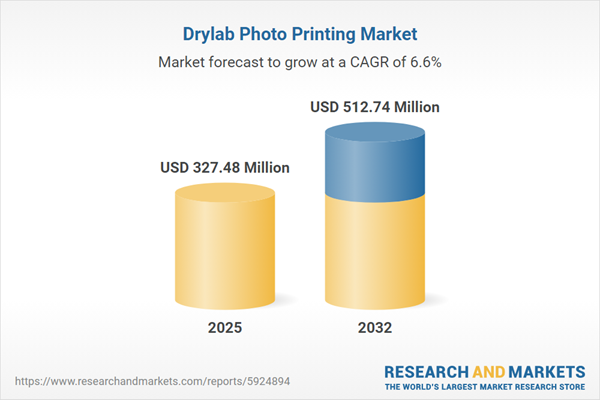Speak directly to the analyst to clarify any post sales queries you may have.
The drylab photo printing market is undergoing significant transformation as digital technologies, evolving customer expectations, and advanced workflow solutions converge. Rapid innovations and regional dynamics are fueling strategic opportunities for industry players across the value chain.
Market Snapshot: Drylab Photo Printing Market Size and Growth
The drylab photo printing market grew from USD 307.32 million in 2024 to USD 327.48 million in 2025, with strong momentum expected at a CAGR of 6.60%, and projected to reach USD 512.74 million by 2032. This expansion reflects rising demand for premium-quality, customizable photo products, underpinned by digital adoption and widespread access to specialized print technologies.
Scope & Segmentation of Drylab Photo Printing
This report delivers granular analysis across several critical sub-segments driving market development:
- Distribution Channels: Drugstores, supermarkets, hypermarkets, superstores, online retailers, direct-to-consumer (DTC) websites, mobile apps, third-party marketplaces, and specialist photo labs.
- Print Formats: Photo books, enlargements, calendars and cards, desk calendars, greeting cards, postcards, wall calendars, posters, and standard prints.
- Service Types: Online, retail, self-service kiosks, in-store kiosks, and mall kiosks.
- Print Sizes: Small, medium, large, and panoramic.
- Print Types: Canvas, fine art, glossy, matte, and metallic finishes.
- Technologies: Dye sublimation (resin-based and ribbon-based), inkjet, and laser systems—all offering distinct advantages in print quality, speed, and substrate compatibility.
- End Users: Business and corporate buyers, consumers, and professional photographers.
- Regional Coverage: Comprehensive insights span key geographies, including North America, Latin America, Europe, Middle East & Africa, and Asia-Pacific, covering developed markets and emerging growth areas.
- Company Case Studies: Analysis includes established manufacturers and innovators shaping industry standards, involving major multinationals as well as technology-driven specialists.
Key Takeaways for Senior Decision-Makers
- Technology advancements, such as AI-enabled workflow automation and high-resolution print systems, are enabling greater precision, reduced turnaround, and enhanced customer experiences.
- Expansion of self-service kiosks and direct-to-consumer digital platforms is driving new customer engagement models and diversifying market access points.
- Personalization and experiential product trends continue to elevate demand for premium, vivid, and customizable outputs in both consumer and business segments.
- Shifts toward sustainability and eco-friendly substrates are motivating operational changes, appealing to environmentally conscious customers and regulatory agendas.
- Regional variations in infrastructure and digital maturity require tailored go-to-market approaches to capture opportunities in different economic and cultural contexts.
- Strategic collaborations—between equipment providers, chemical suppliers, and service operators—are fostering innovation and improving supply chain resilience.
Tariff Impact: Navigating Policy-Driven Volatility
Recent United States tariff adjustments have heightened supply chain and cost management complexity for the drylab photo printing sector. Industry leaders are restructuring sourcing strategies, increasing regionalization of assembly and distribution, and partnering with domestic suppliers to counteract input cost pressures. Adaptability in pricing and service bundling is emerging as a critical lever for maintaining competitiveness in a policy-shifting landscape.
Methodology & Data Sources
This research is built on a multi-phase methodology, combining primary literature reviews, direct interviews with C-level executives and technical specialists, and rigorous quantitative data analysis. Extensive cross-referencing and validation using trade data and proprietary industry intelligence ensure findings reflect real-world trends and actionable insights.
Why This Report Matters: Actionable Insights for the Drylab Photo Printing Market
- Uncovers the interplay of technology, consumer trends, and regional dynamics to inform strategic planning and market entry decisions.
- Offers in-depth segmentation and trend analysis, supporting effective portfolio and channel optimization across multiple end-user categories.
- Equips senior leaders with scenario-based intelligence for proactive supply chain and regulatory risk management.
Conclusion
The drylab photo printing market is defined by rapid technological evolution, intensified consumer personalization, and ongoing disruption within traditional and digital channels. Timely access to deep insights presented in this report positions leaders to drive growth, foster resilience, and capture emerging market opportunities.
Additional Product Information:
- Purchase of this report includes 1 year online access with quarterly updates.
- This report can be updated on request. Please contact our Customer Experience team using the Ask a Question widget on our website.
Table of Contents
3. Executive Summary
4. Market Overview
7. Cumulative Impact of Artificial Intelligence 2025
Companies Mentioned
The companies profiled in this Drylab Photo Printing market report include:- Fujifilm Holdings Corporation
- Noritsu Koki Co., Ltd.
- Dai Nippon Printing Co., Ltd.
- Agfa-Gevaert N.V.
- Eastman Kodak Company
- Canon Inc.
- Seiko Epson Corporation
- Hewlett-Packard Company
- Konica Minolta, Inc.
- Mitsubishi Electric Corporation
Table Information
| Report Attribute | Details |
|---|---|
| No. of Pages | 197 |
| Published | October 2025 |
| Forecast Period | 2025 - 2032 |
| Estimated Market Value ( USD | $ 327.48 Million |
| Forecasted Market Value ( USD | $ 512.74 Million |
| Compound Annual Growth Rate | 6.6% |
| Regions Covered | Global |
| No. of Companies Mentioned | 11 |









